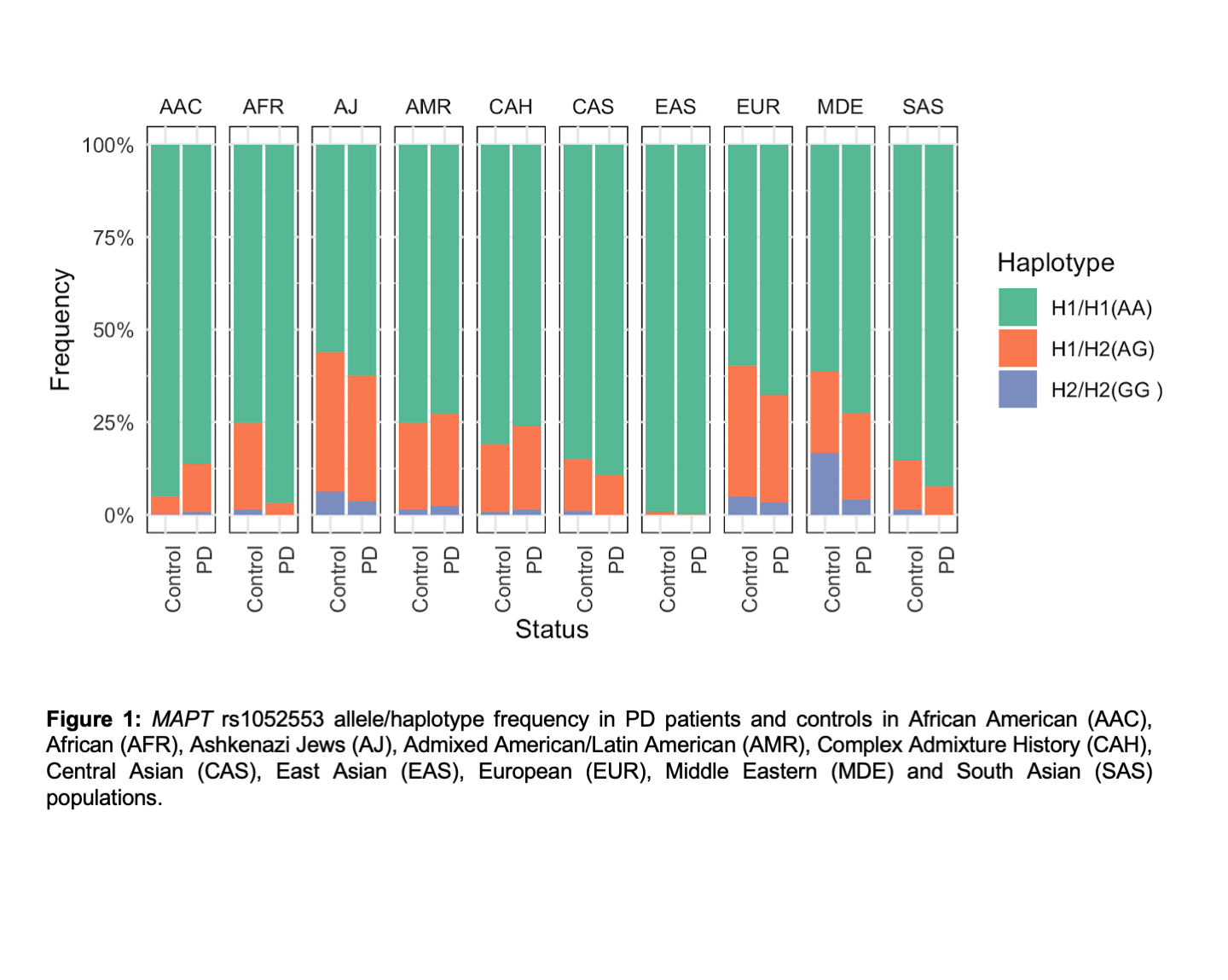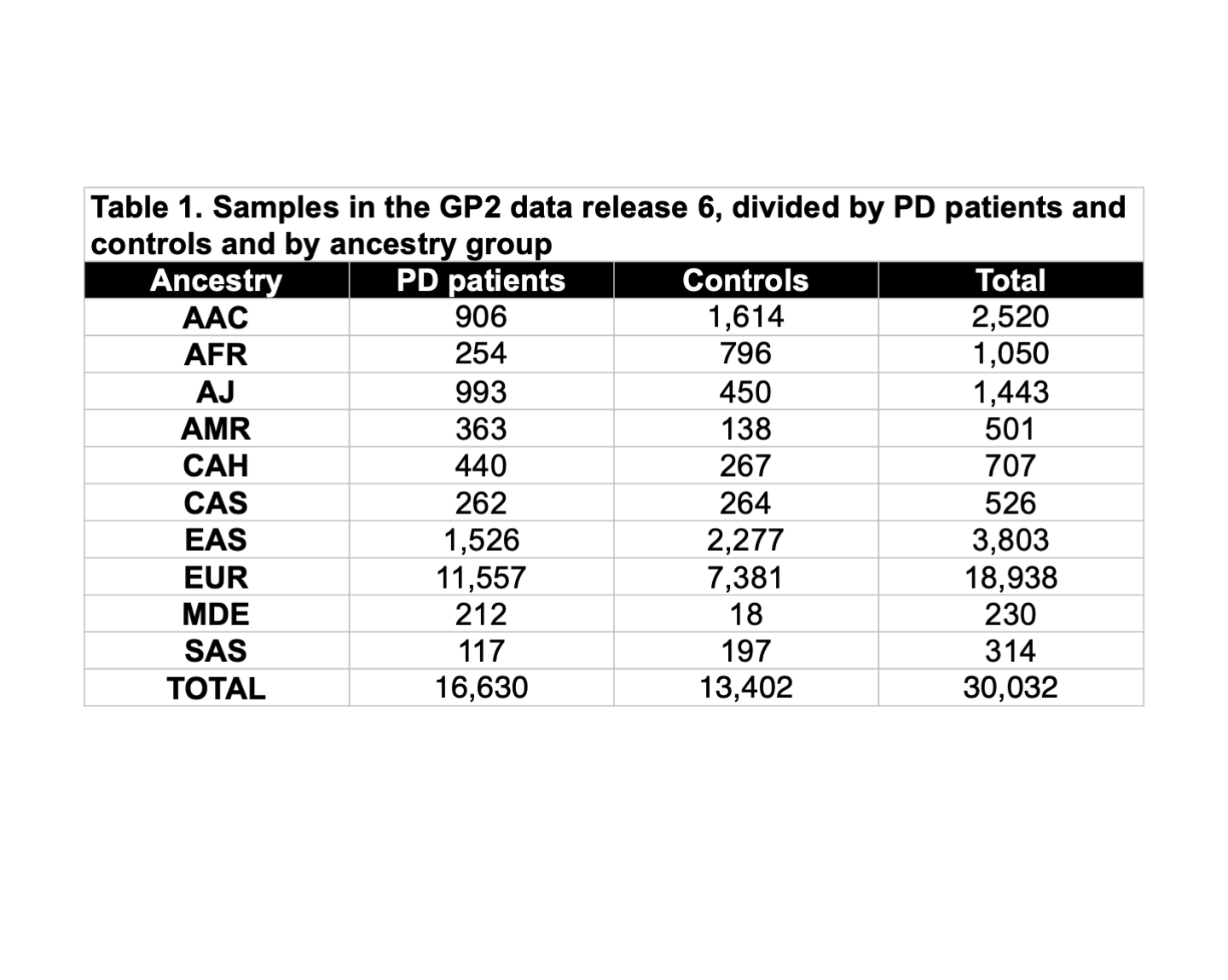Category: Parkinson's Disease: Genetics
Objective: To assess the frequency of H1/H2 haplotypes in MAPT across diverse ancestries from the Global Parkinson’s Genetics Program(GP2) and investigate their association with Parkinson’s disease (PD) risk
Background: The microtubule-associated protein Tau (MAPT) gene has been implicated in tauopathies and is also associated with PD. The association is mediated by the H1/H2 MAPT haplotypes, with the H1 haplotype being associated with increased PD risk and cognitive decline. However, the majority of studies have been done on individuals of European ancestry, and a few studies on non-European individuals have reported a lack of association between the H1 haplotype and PD, necessitating further investigation across diverse ancestries
Method: We employed imputed genetic data from GP2 release 6, comprising 16,630 PD cases and 13,402 controls across 9 ancestry groups: African American (AAC), African (AFR), Ashkenazi Jews (AJ), Admixed American/Latin American (AMR), Complex Admixture History (CAH), Central Asian (CAS), East Asian (EAS), European (EUR), Middle Eastern (MDE), and South Asian (SAS) (Table 1). Sample and variant quality control analyses have been described elsewhere. MAPT H1/H2 haplotypes were investigated using H2-tagging SNP rs1052553 with alleles A and G corresponding to H1 and H2, respectively. Allele and haplotype frequencies, and associations with PD risk were analyzed using PLINK v1.9
Results: The H2 haplotype varied across ancestry groups, ranging from 0.1% in PD patients and 0.4% in controls in EAS to the highest frequencies in MDE, EUR, and AJ of 15.8–20.6% in PD patients and 22.7–27.8% in controls (Figure 1). Statistically significant differences between patients and controls were observed in EUR (p=8.9E-31, OR=0.74, 95%CI=0.70-0.78), AJ (p=0.007, OR=0.77, 95%CI=0.64-0.93), EAS (p=0.02, OR=0.25, 95%CI=0.07-0.84), AFR (p=0.03, OR=0.62, 95%CI=0.04-0.96), and SAS (p=0.04, OR=0.45, 95%CI=0.21-0.97) ancestries. Adjusting for age, sex, and principal components resulted in an association between MAPT H1 and PD in the EUR (p=1.2E-20, OR=0.80, 95%CI=0.71-0.80), AJ (p=0.045, OR=0.79, 95%CI=0.78-0.79), SAS (p=0.03, OR=0.31, 95%CI=0.30-0.33), and CAS (p=0.02, OR=0.43, 95%CI=0.42-0.44) ancestries
Conclusion: Our findings show that MAPT haplotype frequencies vary across populations and underscore the importance of considering genetic diversity in the assessment of MAPT haplotypes in PD
Figure 1
Table 1
To cite this abstract in AMA style:
P. Reyes-Pérez, J. Hor, A. Sanyaolu, T. Toh, K. Senkevich, H. Leonard, K. Brolin. Exploring MAPT Haplotypes in Parkinson’s Disease in a Diverse Cohort: Insights from the Global Parkinson’s Genetics Program [abstract]. Mov Disord. 2024; 39 (suppl 1). https://www.mdsabstracts.org/abstract/exploring-mapt-haplotypes-in-parkinsons-disease-in-a-diverse-cohort-insights-from-the-global-parkinsons-genetics-program/. Accessed December 19, 2025.« Back to 2024 International Congress
MDS Abstracts - https://www.mdsabstracts.org/abstract/exploring-mapt-haplotypes-in-parkinsons-disease-in-a-diverse-cohort-insights-from-the-global-parkinsons-genetics-program/


